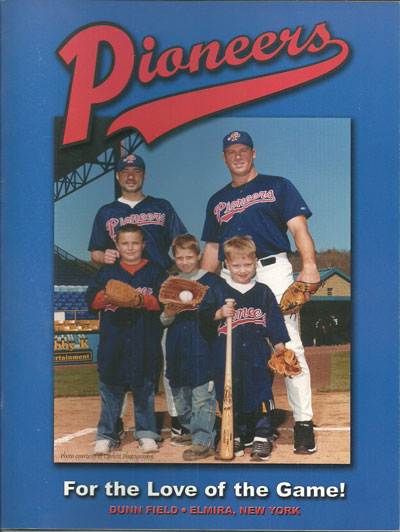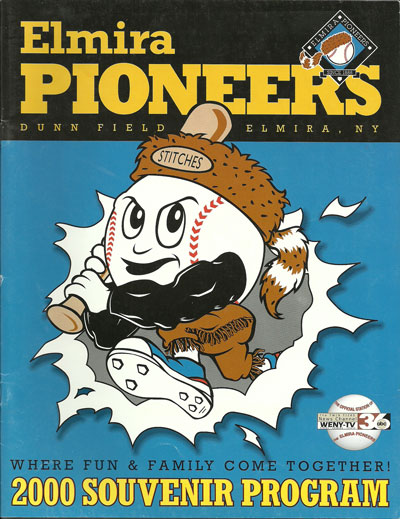Northeast League (1996-1998 & 2003-2004)
Northern League (1999-2002)
Can-Am League (2005)
Tombstone
Born: 1996
Folded:
First Game: June 1, 1996 (W 6-4 vs. Albany-Colonie Diamond Dogs)
Last Game: September 5, 2005 (L 11-2 @ Quebec Capitales)
Northeast League Champions: 1997
Northern League Championships: None
Can-Am League Championships: None
Stadium
Dunn Field (4,020)12003 Northeast League Media Guide
Opened: 1939
Dimensions (2003): LF 325′. CF 386′, RF 325′
Ownership & Affiliation
Owners:
- 1996: Bill Cummings
- 1997-2001: John Ervin and family
- 2002-2006: Hideki Irabu, Hideo Nomo, Mac Suzuki & John Ervin
Major League Affiliation: Independent
Attendance
Tap (mobile) or mouse over chart for figures. Tilting your mobile device may offer better viewing.
Sources:
- 2003 Northeast League Media Guide (1996-2002 figures)
- Baseball America 2004, 2005 & 2006 Almanacs (2003-2005 figures)
Background
A small, isolated city in the Southern Tier of upstate New York, Elmira’s professional baseball history stretches back to 1888. The team joined the Double-A Eastern League in 1923, and spent most of the next fifty years there. With the city hit hard by the industrial Northeast’s economic woes of the 1970’s, the Pioneers dropped down to the Single-A New York-Penn League in 1973. Elmira would eventually be a casualty of the ballpark boom of the 1990’s. The Pioneers left town for a new stadium in Lowell, Massachusetts in 1996.
At the same time, independent baseball had become an outgrowth of the renewed interest in the game. Looking to replicate the success of the Northern League, formed in 1993, indy leagues exploded in 1995. The Northeast League was one of 11 leagues to begin the season (only 8 finished the year). The circuit slogged through a shaky first campaign with six clubs in New York State.
After a mediocre first season, Newburgh Nighthawks owner Bill Cummings moved his club to Elmira’s now-vacant Dunn Field during the off-season. The team’s first hurdle occurred when the old affiliated club’s ownership group was reluctant to let the new club use the trademarked Pioneers name; an alternate “Elmira Cougars” logo and identity had been developed when the prior regime relented at the last minute.

The Indy Ball Era
The new team’s most important asset was its ballpark, Dunn Field. A handsome 1930’s-era 4,000-seat gem, the park was in excellent condition. The city of Elmira invested over $1 million in the park in 1993 to meet National Association specifications. In a downtrodden city that had lost 40% of its population since 1950, Dunn Field was a link to a more prosperous era. City fathers also recognized the importance of keeping professional baseball in Elmira. The Pioneers paid no rent at the ballpark, and, somewhat incredibly, received a subsidy from city coffers that reached as high $50,000 per season during the independent team’s stay.
With former St. Louis Cardinals and Atlanta Braves stalwart Ken Oberkfell as the club’s manager, the “new” Pioneers went 31-41 in their first season in 1996, drawing a respectable 41,501. However, Cummings and the club’s other investors were unfamiliar with the Elmira market. The Pioneers lost a sizeable amount of money in their first year and nearly folded.
The club was rescued by the Ervins, a wealthy area family who purchased the team. Well-connected in the community, they immediately changed the club’s logo and got to work getting on board many of the sponsors and fans who lamented the loss of the affiliated Pioneers.
With fans starting to warm up to the independent club, attendance rose to 52,372 in 1997. On the field, despite an unspectacular 44-38 regular-season record, the Pioneers caught fire in the playoffs. They won the league championship under veteran independent manager Dan Shwam. It was the club’s only title during its independent baseball era.
In 1998, the Pioneers were unable to recapture the previous year’s magic, and proffered a forgettable 32-51 campaign, with attendance virtually unchanged at 52,436. However, now at eight teams, the Northeast League was slowly gaining respectability among independent leagues.
At the same time, the Midwest-based Northern League had begun to explore markets in the Northeast. With the logistical and financial hassles that would inevitably arise with just a couple of teams far from the league’s main territory, the Northern instead merged with the Northeast League, creating a 16-team circuit that kept the “Northern League” name.
The two 8-team conferences only met for the midseason All-Star Game and the championship series, so it was more or less business as usual for the individual clubs. Unfortunately for the Ervins family, the Pioneers were still losing money, and the owners struggled with the realities of operating a team in Elmira, frequently ruminating during the off-seasons about whether they could continue to keep the club alive.
With only 90,000 people in Chemung County, and few other population centers nearby, potential corporate sponsorship for the team was limited. Furthermore, the nature of the area’s small, stagnant business community didn’t lend itself particularly well to sponsorship. Since everyone in town already knew exactly who and where they were to begin with, Elmira’s small businesses didn’t particularly feel the need to promote themselves with a fence sign or major ad campaign.
As far as fan support, the 1997 championship helped, as did division championships in 2000 and 2001, but the Pioneers struggled to convince fans of independent baseball’s merits, a common issue for many indy teams. The quality of play in the Northern League was certainly better than the New York-Penn League, and the team played to win, rather than to develop fans for a faraway Major League affiliate. Yet, the previous sixty years of seeing the likes of Jim Palmer, Earl Weaver, Wade Boggs, and Curt Schilling come through town had conditioned Pioneers fans to watch affiliated baseball.
The constant uncertainty surrounding the club’s future didn’t help. Fans and sponsors grew tired of frequent “Save the Pioneers” campaigns that tried to shore up the team’s limited resources.
Japanese Experiment
Prior to the 2002 season, the Ervins sold 51 percent of the club to Silex Corp., a Japanese ownership group led by former major-league pitchers Hideo Nomo, Hideki Irabu and Mac Suzuki. The group bought the Pioneers with the intention of developing Japanese players in Elmira, and moving them to major-league organizations.
With a handful of Japanese players on the roster in 2002, the team put together its best season as an independent club. The team went 54-36, but lost in the first round of the playoffs. Patrick McKernan, a former assistant GM at Triple-A Albuquerque, had been hired as the Pioneers’ GM prior to the season, and the club’s attendance remained steady, in the 1,500 per game range. With the experienced McKernan running a tighter ship, the team lost the least amount of money in its independent era in 2003 (around $150,000).
Nevertheless, ownership’s enthusiasm for running the Pioneers was waning. The club took the field with a significantly reduced budget in 2004.
The experiment with Japanese players was lackluster at best. Few players of any consequence were sent to the team. Only four Japanese players suited up for Elmira for 2004, and just two in 2005. Elmira’s Asian population was practically non-existent so fans didn’t particularly identify with the few Japanese players who showed up. Furthermore, the Pioneers had to deal with foreign players’ typical visa issues. Not only could getting them into the country be challenging, but crossing the Canadian border was also a headache. Japanese players were frequently left behind in Elmira when the Pioneers went to play league powerhouse Quebec.
With former Detroit Tiger Greg Keagle, a native of neighboring Horseheads, as the club’s manager in 2004 and 2005, the bare-bones Pioneers trudged through two woeful seasons on the field, going 32-60 and 28-64, respectively. Ownership finally called it a day after the 2005 campaign. The Pioneers transitioned to the amateur New York Collegiate League, where they remain today.
Links
##


One Response
Great write-up on the Pioneers, especially the mention of Dan Shwam and the failed Japanese player experiment.